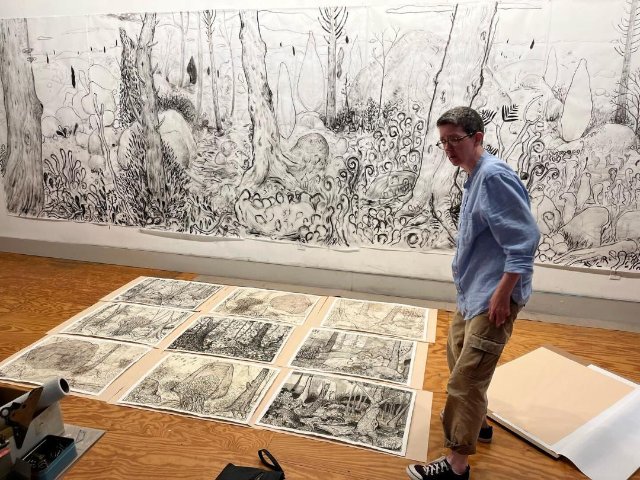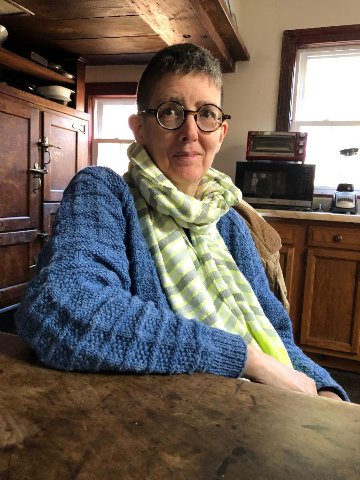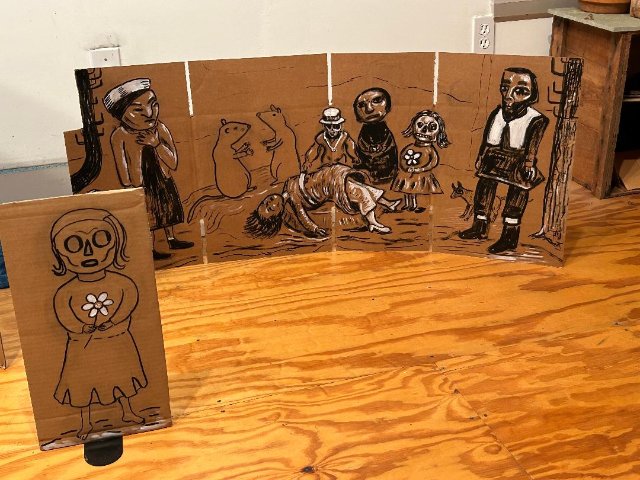Gloucester's Legendary Dogtown Common
Conjured by Playwright Peter Littlefield and Artist Gabrielle Barzaghi
By: Charles Giuliano - Feb 25, 2024
From Pigeon Cove three miles back in the wood
The boulders heap up in a wild moraine—
Gray ruined tabernacles of the rain
And starry solitude:
There lie the lonely commons of the dead—
The houseless homes of Dogtown. Still their souls
Tenant the bleak doorstones and cellar holes
Where once their quick loins bred
Strong fisher men who fought with storms at the masthead,
And women folk who took their bitter toll
Of death, with only their old dogs to be a memory.
Dark phantasies,
Hatched of long-brooding winter silences,
Stretched their starved spirits taut
With mystic yearnings toward forbidden sins.
Narrator from the play Dogtown Common
It was Saturday afternoon, the last day of a productive week in November visiting with family and friends in Gloucester. We set off for a long, narrow, overgrown lane deep into the heart of darkness.
Gabrielle Barzaghi was a colleague when we both taught at New England School of Art & Design, Suffolk University. In recent years we have connected each time Astrid and I spend time on Cape Ann. I have followed with great interest her large, figurative, expressionist, narrative works on paper.
They evoke the tragic works of Paula Modersohn-Becker (8 February 1876 – 20 November 1907) a German Expressionist painter. Her works are rare but pack a punch. That sensibility is strongly felt in Gabrielle’s work which is more evocative of a Germanic than American aesthetic. She refers to her White Russian heritage stemming from when her ancestors fell from prosperity evicted by the Bolsheviks.
The work, which exaggerates reality, is redolent of narrative and iconography. Compared to much contemporary art it has specificity and meaning. The strong aesthetic reflects her stoic, ascetic manner. Her approach to lifestyle and work is no frills and pragmatic. With closely cropped hair she peers out at the world through round, accented glasses. She conveys little interest in fashion or style, but has her own look
When I pointed to a jaunty patch accenting one bottom leg of a pair of loose fitting jeans she laughed. Rather than a fashion statement it was a patch over a hole of what had been her husband, Randy Carr’s old jeans.
What I have come to enjoy over the years is the intensity of our conversations. It always entails matters of substance often focused on our views of art, the art world, and our careers. Cutting to the chase there is no small talk.
This time it was even more so as tea and cookies accompanied a salon and séance of ersatz philosophes. I was on my best Voltaire. The gathering was enhanced by Randy’s deep Gloucester roots and Astrid’s reflections as a former administrator of art, science and technology. She spent the week gathering beach detritus as material for an exhibition in May.
Rounding out the group was Peter Littlefield, a polymath of theatre and opera, who grew up within walking distance of Pip and me in Norwood Heights, Annisquam. He and Pip were closer in age and had a mutual best friend, the impish and whimsical, Clark Ross.
We connected with Peter during a Manship Residency last November. Since then, Peter and Gabrielle serendipitously worked together on a play sponsored by Gloucester 400th Plus and staged at Windhover Center for the Performing Arts in Rockport.
Dogtown Common by Percy MacKaye
Adapted and Directed by Peter Littlefield with Peter Berkrot, Judy Brain, Duncan Hollomon, Cass Tunick, Brain Weed and Deirdre Weed
Music arranged and performed by Kathleen Adams
Forest Form sculptures by Liz Sibley Fletcher
Backdrop by Gabrielle Barzaghi
Randy and Gabrielle are deep in the woods of Lanesville which abuts Annisquam. Living on 20 acres they often hike in Dogtown with its carved boulders, Whale’s Jaw formation, and abandoned cellar holes.
There had been an earlier iteration of the play and Gabrielle signed on for a second run to create a large, work on paper backdrop for the play. It was her first venture into scenic design and solidified what had been primarily a production entailing dolls and props. The moody, spooky drawing evokes Nordic forests created by Edvard Munch.
With enthusiastic respect Peter noted that she had attended all of the rehearsals. Unfortunately, there are few if any reviews in Gloucester but through great word of mouth the second run sold out. Those we spoke to loved it.
I asked Peter to send notes.
“Percy MacKaye’s 1922 poem, Dogtown Common, is a beloved document of Gloucester lore. It tells the story of two legendary figures, Tammy Younger and her niece Judy Rhines, shunned for practicing witchcraft.
”It was inspired by Charles Mann’s 1906, The Story of Dogtown or In the Heart of Cape Ann, that compiles recollections about the outsiders, berry-pickers, subsistence farms and self-proclaimed witches that inhabited Dogtown after it was abandoned in the early 1800s.
“The poem has a history with The Windhover Center for the Performing Arts, where Ina Hahn performed it more than once. Lisa Hahn, the current Executive Director, asked me to do a new production.
”Windhover had been a dairy farm. It seemed the perfect place to stage the poem because it looks the way Dogtown must have looked before it was abandoned after the Revolution. Windhover’s production combines the idea of an installation with a staged reading like a ghost story.
”The performers sit around a table and build an image of Dogtown as they enact the poem. The performance is as fully staged as a conventional play, but we put the emphasis on the imaginative act of engaging a poetic text.”
It’s difficult for critics to form relationships with those they write about. It’s essential to respect the work. When reviewing the work the challenge is to be critical and honest with the reader. That can be challenging and result in conflicts of interest. There is the overriding benefit, however, of invaluable insights into the creative process.
When I covered jazz, for example, conversations with performers took me to school about their work. That included dialogues with masters: Miles Davis, Duke Ellington, Stan Kenton, Elvin Jones, Carmen McRae, Ornette Colemen, Bill Evans, McCoy Tyner, Anita O’Day, Captain Beefheart, Dexter Gordon, Gerry Mulligan, and Phillip Glass to mention a few.
Things, however, do not always go according to plan. Rahsaan Roland Kirk, a blind musician, could play three horns at once. Over dinner he gave me a mouthful. “It’s the muthahfuggin white critics that are running the music.”
The artist is the primary source for engaging the work. Most critics deliberately avoid knowing the artist over concern that it will influence and compromise what they write. Too many reviews, particularly in theatre and film, are plot summaries with little or no critical analysis.
Over the years, Gabrielle has shown with the Cape Ann Museum, which owns her work, as well as regularly with Matthew Swift Gallery. A lack of critical discourse undermines that effort. There have been eclectic Cape Ann blogs but none with depth and insight for the fine arts.
Lucas Cotterman and Caroline Harvey of Dogtown Books are in the process of launching a journal by and about Cape Ann. Hopefully that will be a game changer.
Surely a lot more can be done by the Cape Ann Museum to support and promote an ever expanding community of progressive contemporary artists. The museum has the space in its annex to develop lively programming but remains apathetic. Director, Oliver Barker and chief curator, Martha Oakley, have other interests. The museum desperately needs an ambitious young curator dedicated to modern and contemporary art.
There is a lot of new money on Cape Ann. In the 19th century there were the patricians of the gated community of Eastern Point. Commoners are not allowed. One used to be able to tell the guard that “I’m visiting the light house.” Now it’s a private home.
With town water and sewer installed on Cape Ann some time ago, upscale, million dollar condos are being jammed into every vacant space. Some say that Gloucester as we knew it has been raped and pillaged by the mega rich. Poet Charles Olson sounded that alarm decades ago.
Assuming a contrarian position Randy argues “Now Gloucester no longer dumps raw sewage into the harbor which is a good thing.” The influx of money and taxes is saving what was a doomed economy.
Everyone has their benchmark for Gloucester and its nostalgia. For me, he points out, it is the Gloucester of the 1950s and 1960s as my sister and I wrote about in our book Annisquam: Pip and Me Coming of Age.
“For kids growing up today, this is their Gloucester,” Randy said. “What about the Gloucester of 1923, when the Hoppers were around, or 1800, or 1500, or 1200?”
It was getting late in the afternoon when I asked if we might have a studio visit.
With work in progress and “a mess” she was reluctant but relented. Still in recovery it was a challenging climb but Randy was behind me for security.
The house they designed has a large open studio on the second floor. It is always energizing to visit a busy studio. You get to engage with the thinking process of the artist.
Though the Dogtown show is over and her backdrop in storage, she continues to be intrigued by the saga, accusations of witchcraft, rape and murder of Judy Rhines.
Laughing she said “It’s like I didn’t want summer camp (working on the play) to end. I still had the props (dolls that functioned as ‘familiars’ in the drama) and wanted to do something with the characters.”
Using cardboard which can be configured to stand up she created a new background. Into this are inserted elements of the gruesome narrative and related props.
While she pined for the rigid, patriarchal minister, Rhines was raped and murdered by the sailor Peter Bray. He is portrayed as a Popeye character with corncob pipe and bulging forearms.
What she has created so far is arresting work in progress. It is bold and exciting that it is evolving as a theatrical installation. Finding a venue to display it comes next.
That comes to the fore with the discussion of support for contemporary art.
As John Lennon put it “For our last number I’d like to ask your help. Would the people in the cheaper seats clap your hands? And the rest of you, if you’ll just rattle your jewelry.”
All together now.







